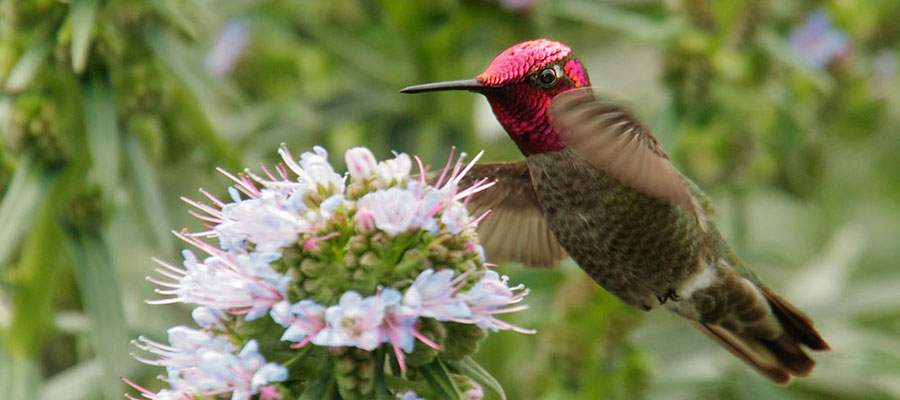
Hummingbirds are the most colorful birds in the avian world. Evolution has shaped these tiny marvels into living gems, with their plumage playing a crucial role in defending territories and attracting potential mates.
Let’s delve into the fascinating mechanics of how hummingbirds get their colors to unravel the mysteries behind their brilliant, shifting hues.
On this page
How Do Hummingbirds Get Their Color?
Unlike many other birds, the vibrant hues that adorn hummingbirds do not result from pigments. Most of their colors come from iridescence, a phenomenon where colors are produced by the interaction of light with specialized structures.
In the case of hummingbirds, these structures are hollow, air-filled, pancake-shaped proteins found in barbules, the smallest filaments of their feathers. These flat structures have up to 15 layers. As light hits the top layer of the barbule, it refracts. Some of it gets reflected, while some passes through to the successive layers.
The resulting color is dependent on the viewing angle and the composition and spacing of these layered structures. Thicker layers produce hotter colors, such as yellows, oranges, and reds.
On the other hand, if they are thinner and more densely stacked, then the resulting colors are cooler, including blues and purples. Sometimes the iridescent part can also appear black due to light waves canceling each other out.
Related: Hummingbird Facts
Notably, this dazzling display is predominantly a male trait. Females and juveniles, on the other hand, adopt a more understated and dull appearance.
Most Vibrant Hummingbirds in The U.S.
Allen’s Hummingbird
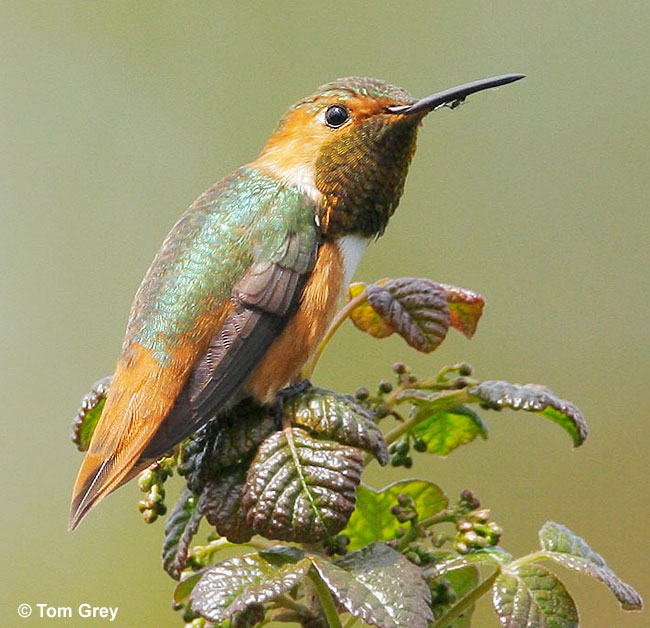
Allen’s Hummingbird is amongst one of the smallest hummingbird species. They are native to the western coastal regions of North America, particularly along the Pacific coast from Oregon to southern California, but can only be found year-round in the Channel Islands and Los Angeles.
Related: Most colorful birds in the U.S.
Male Allen’s Hummingbirds boast a stunning combination of colors, with vibrant iridescent red-orange throats, bellies, and lower backs and greenish backs and caps. The gorgets and upper backs of the males shine with a radiant and almost metallic sheen. In contrast, the females and juveniles are generally more subdued, with greenish-gray plumage and dull orange.
They are very early migrants, with some reaching their breeding grounds in North America as early as January. Look for them in chaparral and coastal shrubs, listen out for their sharp squeals and bumblebee-like buzzing.
Anna’s Hummingbird
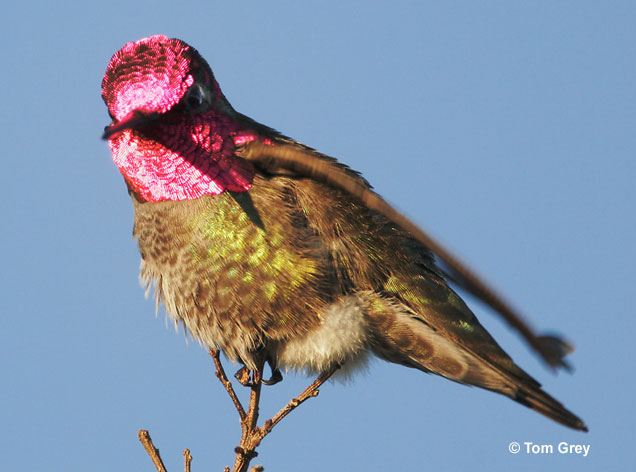
Anna’s Hummingbird is a dazzling resident of the western coast of North America, ranging from northern Canada to Baja California. These lively birds have adapted to a variety of habitats, from coastal scrubs and gardens to open woodlands and lower mountain slopes. Look for Anna’s Hummingbirds at feeders and big and colorful flowers. Males often sing high up in small trees or bushes.
What sets Anna’s Hummingbirds apart are their striking gorgets and the fact that even females have a small one.
Depending on the lighting conditions and the bird’s movements, the vibrant hues can shift from deep magenta to bright pink, green, or even fiery red, contrasting beautifully with their overall metallic green plumage.
However, without sunlight, it may appear gray or dull brown.
Black-chinned Hummingbird
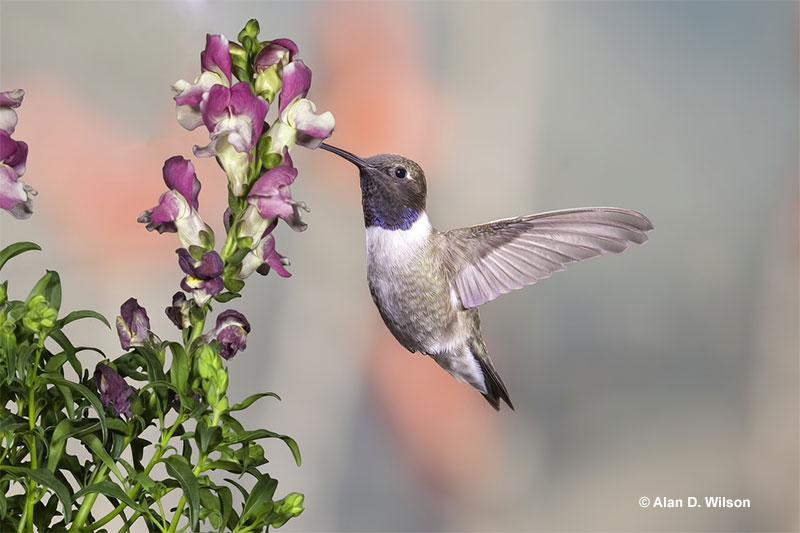
The Black-chinned Hummingbird is a modest yet enchanting specimen that breeds in western North America and winters as far south as Mexico. They are not picky when it comes to choosing a place to live, provided there are tall trees and lots of flowers. If you’re looking for one, keep an eye on feeders and tall trees with dead branches.
Related: How to attract hummingbirds?
This hummingbird is dull metallic green above and subdued grayish-white below. Males look especially refined with their velvety black throats, adorned with a thin, iridescent purple base. Females, in their own muted beauty, have a pale throat.
While some hummingbirds prefer to feed on flowers of a certain color, these are drawn to flowers that share the colors with the previous blooms they fed on.
Broad-tailed Hummingbird
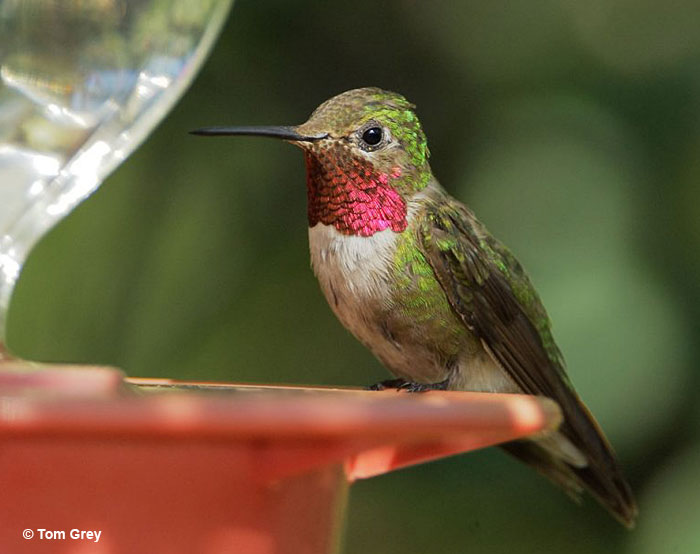
Broad-tailed Hummingbirds grace the open forests and meadows of the western United States mountains only for a few months. They’re tough for such little birds, as they may often have to brave below-freezing temperatures by going into torpor.
Locating them is made easier by the loud and metallic cricket-like trilling they produce while flying. However, as they are quite agile creatures, you have more luck seeing them by scanning nearby meadows, flowers, or even hummingbird feeders rather than the skies.
Their heads look proportionally bigger than most other hummingbird species. Both sexes have dazzling iridescent green uppersides, white undersides, rounded black tails, and a white eye ring. Males have warm rose-magenta throats and greenish flanks, whereas females have pale throats spotted with green and cinnamon flanks.
Calliope Hummingbird
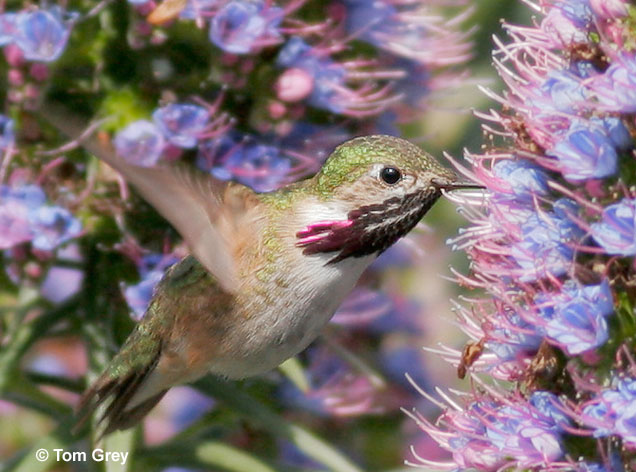
Named after the muse of eloquence and epic poetry, the Calliope Hummingbird is a diminutive marvel and the smallest bird native to the United States and Canada. Despite their miniature stature, these territorial beings fearlessly challenge larger birds, such as Red-tailed Hawks, during their breeding season.
As the smallest known long-distance avian migrant, they navigate between their winter sojourns in south-central Mexico’s rainforests and their summer residence in southwestern Canada’s tundras and taigas. Beyond these extremes, Calliope hummingbirds also inhabit grasslands, deserts, scrub forests, and alpine habitats.
They are uniquely monotypic, boasting short wings, producing a distinctive bumblebee-like sound in flight, and having uncharacteristically short bills. Both males and females are lovely glossy green above and whitish below. Males also have wine-red streaks resembling narrow petals on their gorget.
Costa’s Hummingbird
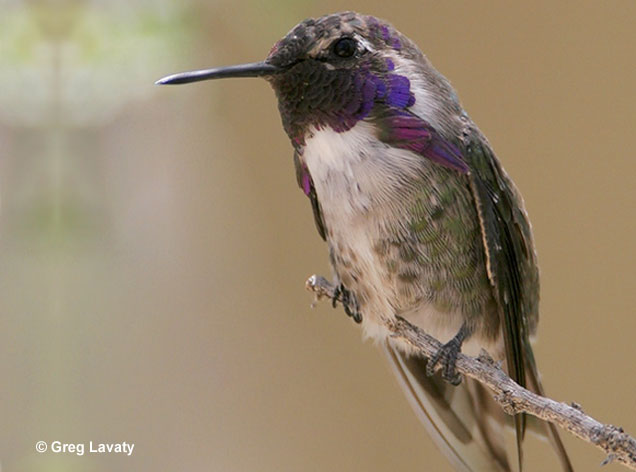
If you want to see a rather unique-looking hummingbird, you will have to visit the arid scrubby regions of the southwest United States or northwest Mexico.
Costa’s Hummingbirds, among the tiniest of their kind, have a distinctive hunch-backed posture and short tail, making them a bit easier to recognize. Males have iridescent green back and flanks, complemented by a black tail and wings, purple caps and faces, and a white underside.
Their iridescent purple throat feathers flare out like a mustache. In contrast, females are more subdued, completely lacking the vibrant purple.
Noteworthy is their remarkable ability to enter a state of hibernation on cold nights, slowing down metabolism, heartbeat, and respiration rates. To sustain their energy-intensive lifestyles, Costa’s Hummingbirds diligently visit around 1,840 flowers daily.
Ruby-throated Hummingbird
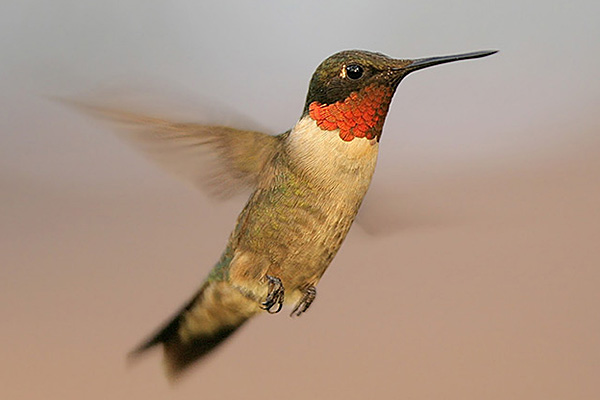
Photograph © Greg Lavaty.
Ruby-throated Hummingbirds are found in North and Central America, uniquely recognized as the only hummingbird breeding in eastern North America. Inhabiting diverse environments such as gardens, wood edges, and other semi-open habitats, these agile birds are known for their metallic green upperparts and grayish-white underparts, complemented by near-black wings.
Adult males feature an eye-catching iridescent ruby-red gorget (hence the name) bordered by velvety black, along with a forked black tail displaying a subtle violet sheen.
They also prefer to feed on red and orange flowers. Despite the vibrant red, its iridescence appears dull black from certain angles. In contrast, females have a notched tail with outer feathers banded in black, white, and green, and a white throat with dusky streaks.
Rufous Hummingbird
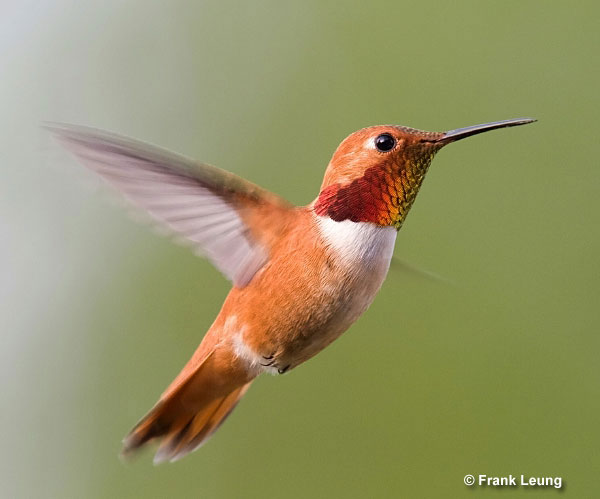
Rufous Hummingbirds are small coppery birds that can be found in shrubby to open woodlands from coastal to mountainous areas in northwestern North America. Males are incredibly territorial, chasing away all intruders, including those bigger in size, even on migration. So, if you have Rufous Hummingbirds frequenting your hummingbird feeder, chances are they are going to make it tough for other visitors.
The majority of adult males are distinguished by their almost overall vibrant coppery plumage, except for their white breast, while females and juveniles are subdued green above and have rusty flanks.
Males have metallic coppery throat, whereas females have a pale throat with a spot of orange. Keep in mind, however, that some individuals have green backs instead of orange ones, so they are very easy to confuse with Allen’s Hummingbirds.
Broad-billed Hummingbird
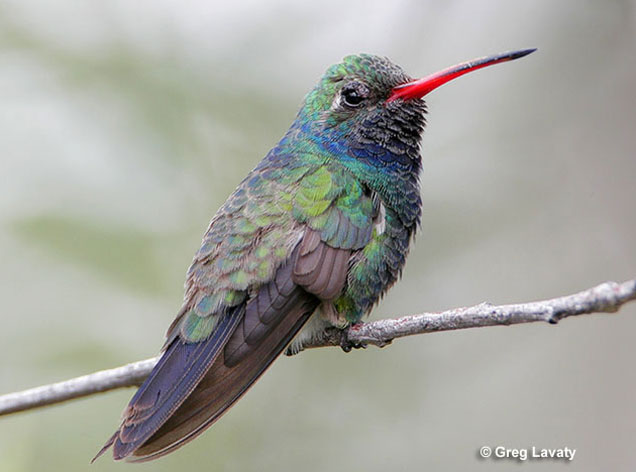
One cannot discuss Broad-billed Hummingbirds without marveling at their vibrant plumage. Males of the species have a metallic emerald body and boast an iridescent throat, often shimmering in hues of electric blue, emerald green, and fiery red.
True to their name, Broad-billed Hummingbirds feature a distinctive bill that sets them apart from others. The bill is wider than that of many hummingbird species, providing these agile fliers with a unique advantage in extracting nectar from a variety of flower shapes.
If you want to meet one, you would have to travel to the southwestern US or Mexico. They inhabit arid and semi-arid regions, especially canyons, foothills, and streambeds which offer enough appropriate plants to feed on.
Lucifer Hummingbird
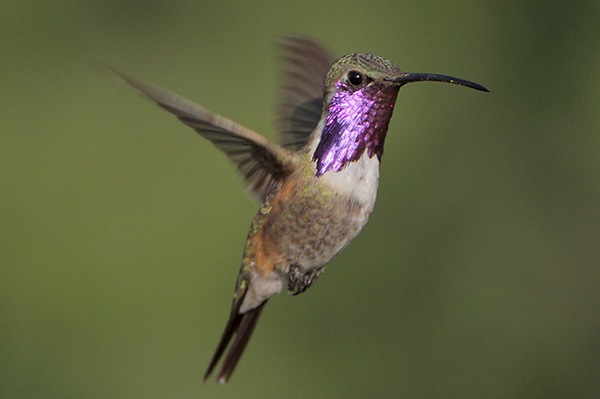
The Lucifer Hummingbird, native to the southwestern United States and Mexico, can be seen flitting around in canyons, scrub, desert foothills, or dry washes. This species is also called Lucifer Sheartail due to its forked, narrow tail.
Adults have a beautiful iridescent green back and a buffy whitish underside. Males have iridescent purple gorgets that can also appear golden if viewed from the correct angle. Females are more subdued with cinnamon flanks and pale throats.
Rivoli’s Hummingbird

The Rivoli’s Hummingbird, also known as the Magnificent Hummingbird, lives up to its name with an appearance that is nothing short of breathtaking. The male, in particular, boasts an iridescent plumage that glows like a trove of precious gems when struck by sunlight but remains dark, almost black when not.
Its crown is adorned with a brilliant violet-blue hue that seamlessly transitions to an emerald green on its back, creating a mesmerizing gradient of colors. The male’s throat is bright sea green. Females are more modest – simply greenish above and grayish below.
Due to their appearance and habit of breeding in the mountains of the southwestern United States and Mexico, they’re also called mountain gems. They may hybridize with other hummingbird species, including Blue-throated Mountain-gems and Broad-billed Hummingbirds. The resulting offspring may look confusing, but captivating nevertheless.
Fun Facts About The Colors of Hummingbirds
- Hummingbirds are the most colorful species, with their range of colors exceeding the total color diversity of all other birds combined.
- There are many ways to call a flock of hummingbirds, but almost all refer to their mesmerizing plumage. The most popular ones are ‘bouquet,’ ‘a glittering,’ and ‘a shimmer.’
- As a general rule, only male hummingbirds have an iridescent throat patch, also known as gorget.
- Male hummingbirds have evolved to be extremely colorful to be successful in attracting females and defending territories. Females, although beautiful in their own way, usually have duller and more muted colors to blend into the surroundings and avoid falling prey.
Hummingbird Colors – Frequently Asked Questions
What determines the color of a hummingbird?
The color of a hummingbird is primarily determined by the microscopic structure of its feathers, creating iridescence through the interference of light waves. Some species also have pigments like melanins and carotenoids in their feathers, adding non-iridescent colors to their vibrant appearance.
What color are female hummingbirds?
Female hummingbirds typically have more muted and subtle coloration compared to their male counterparts. Their feathers are often green or brown, providing better camouflage when nesting and protecting their eggs.
What is the most colorful type of hummingbird?
One of the most colorful hummingbirds is the Red-tailed Comet.
What is the rarest color of hummingbird?
The rarest hummingbird color is white – a true albino hummingbird.
Is there a rainbow-colored hummingbird?
Although there may not be a rainbow-colored hummingbird specifically, a few dazzle in a big range of colors, such as the Fiery-throated Hummingbird.
